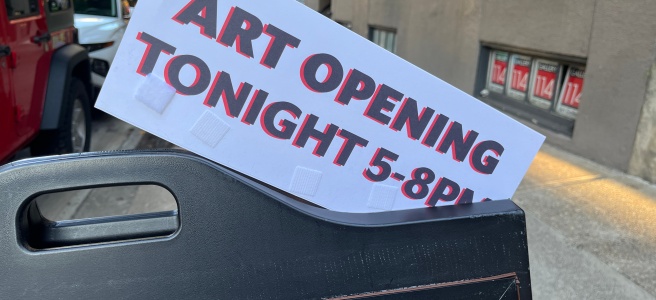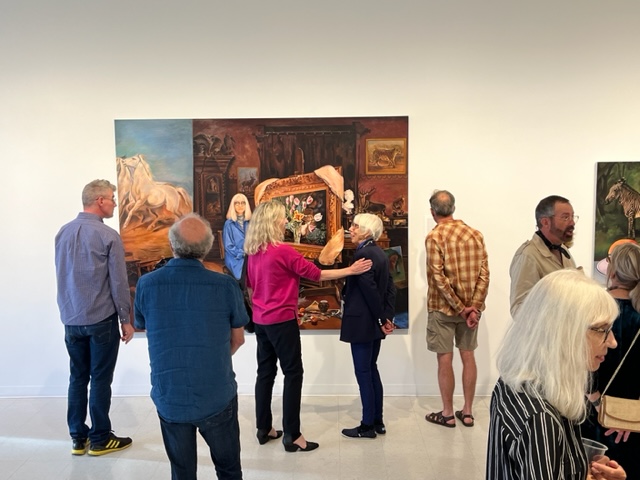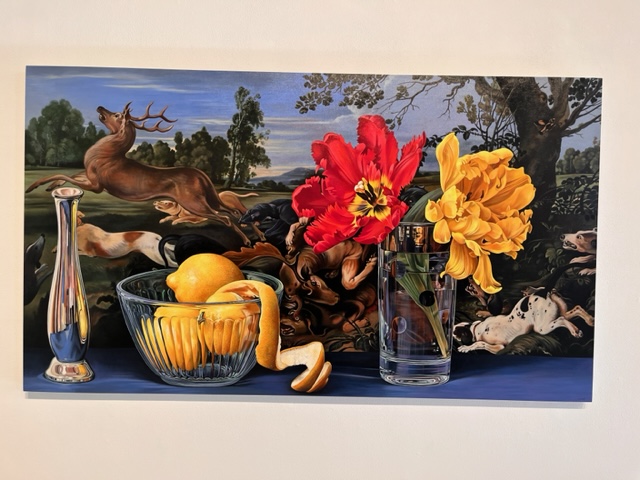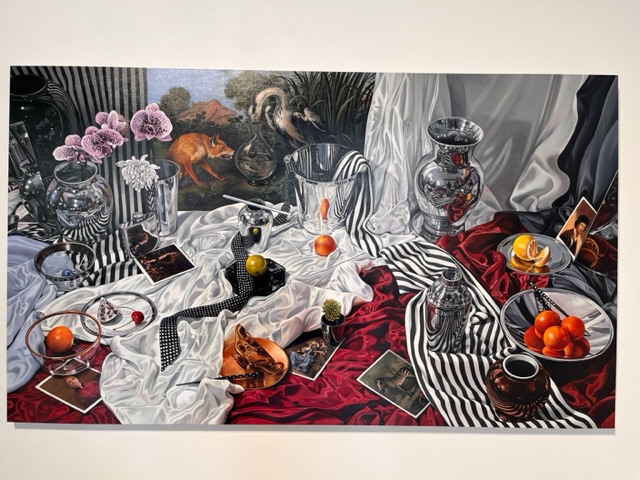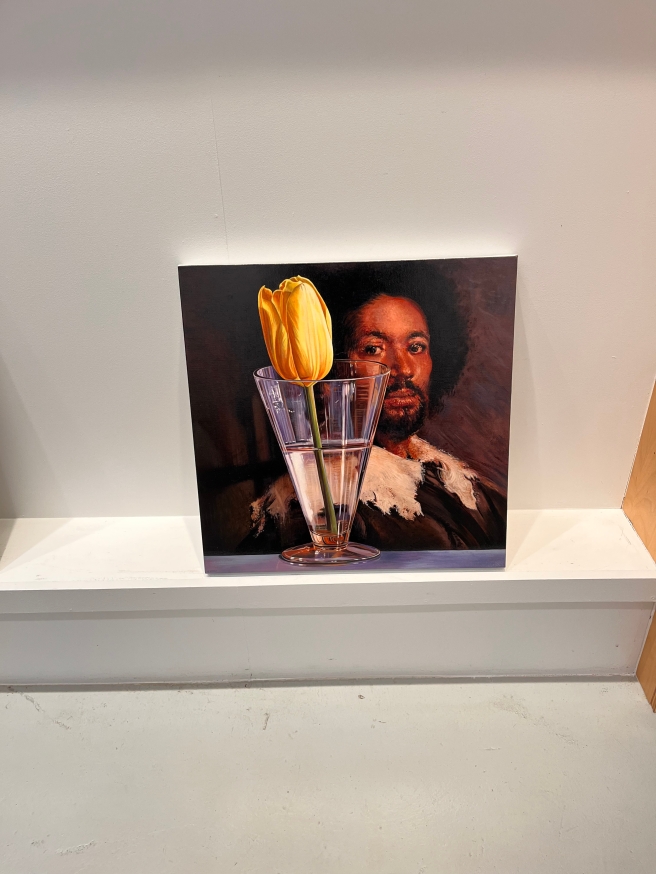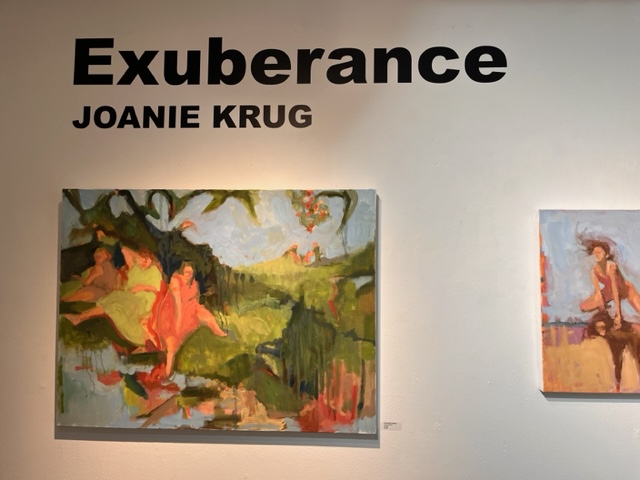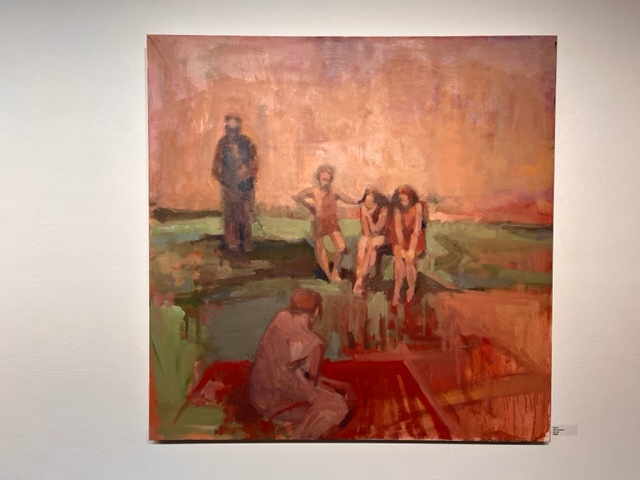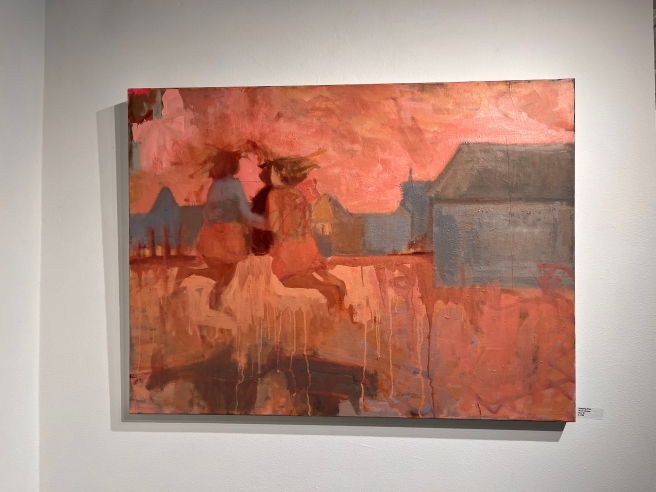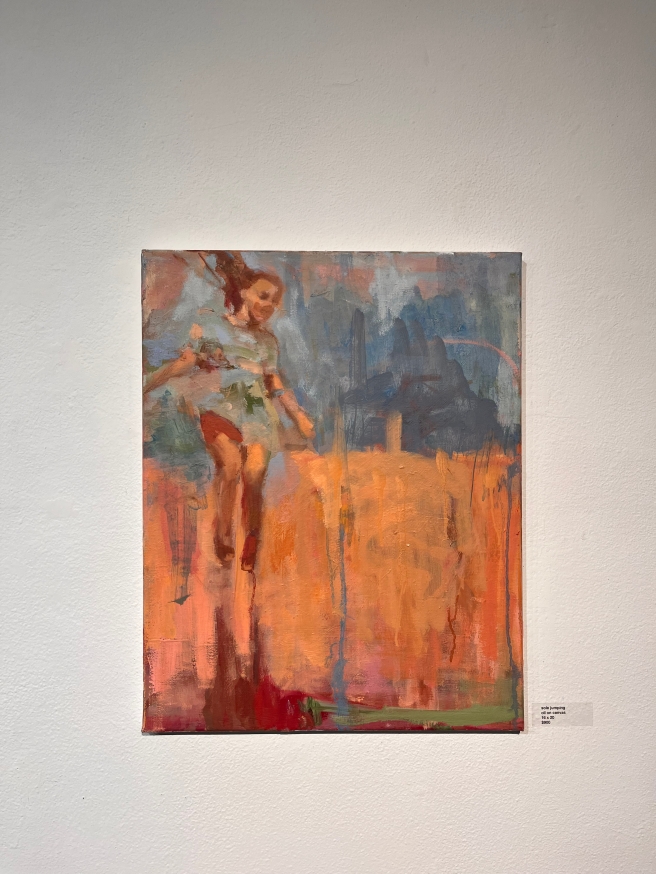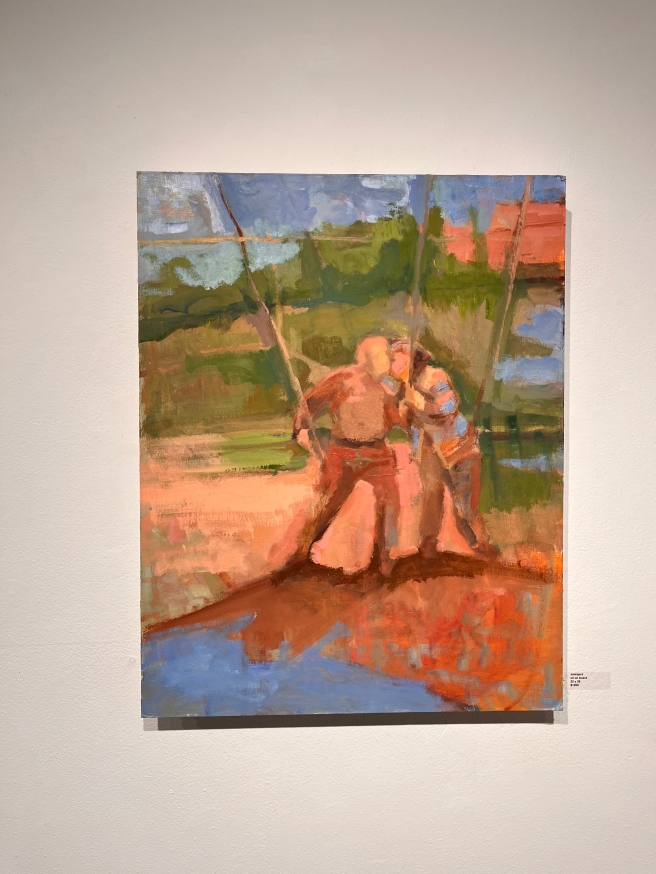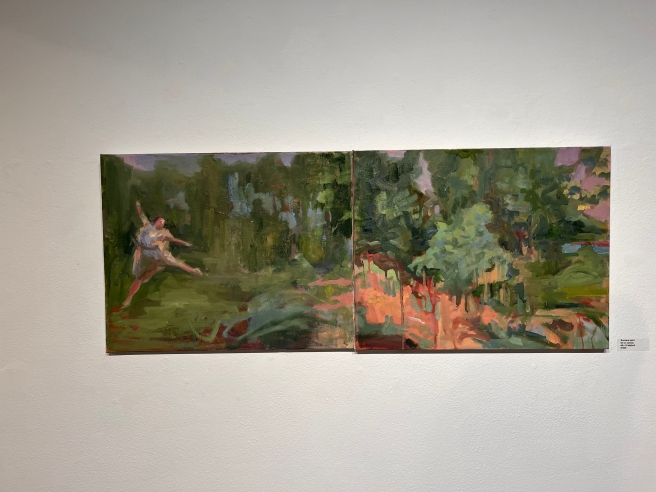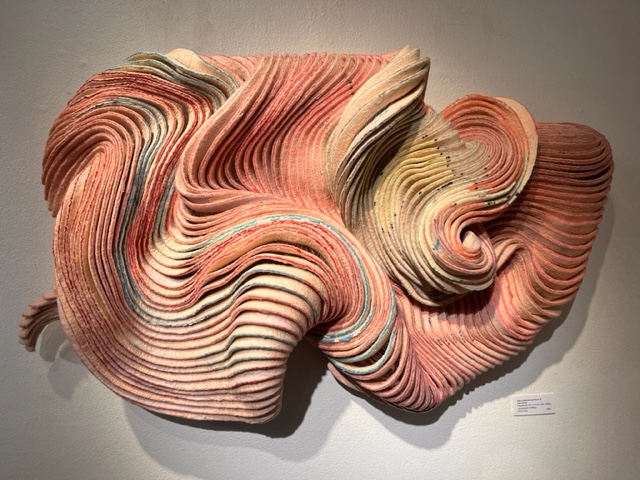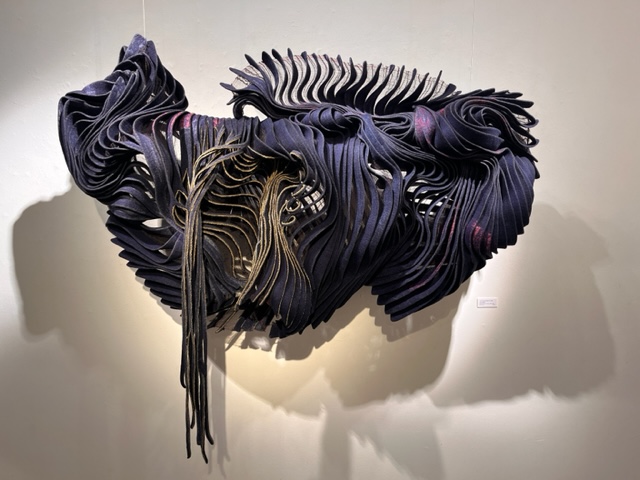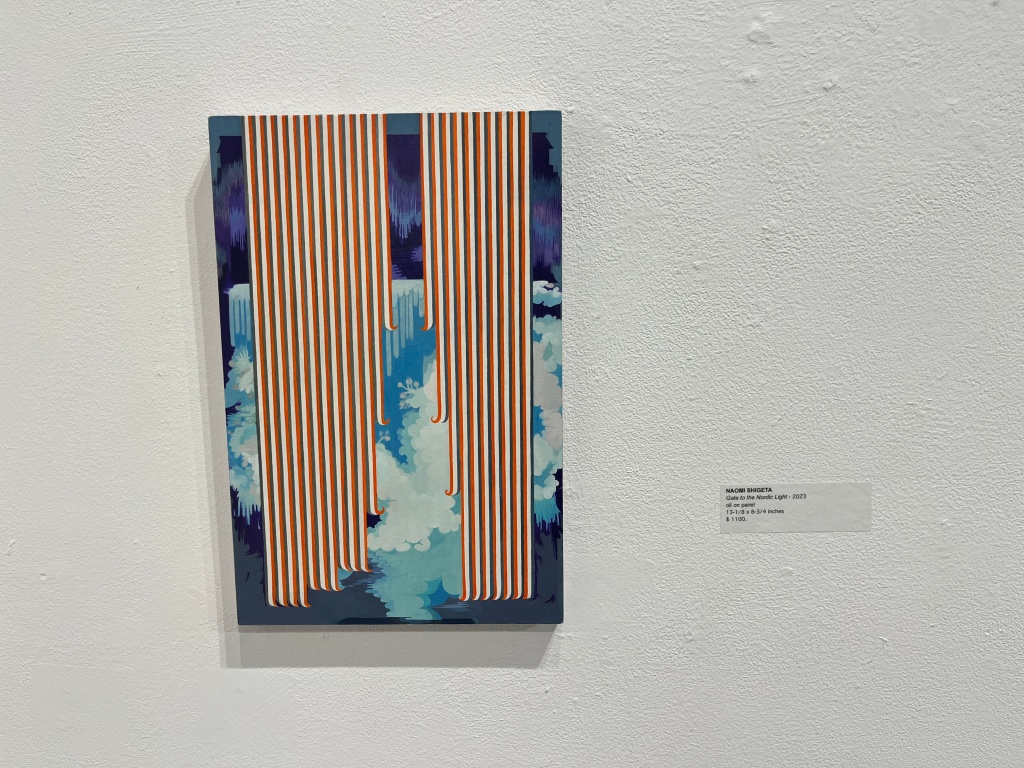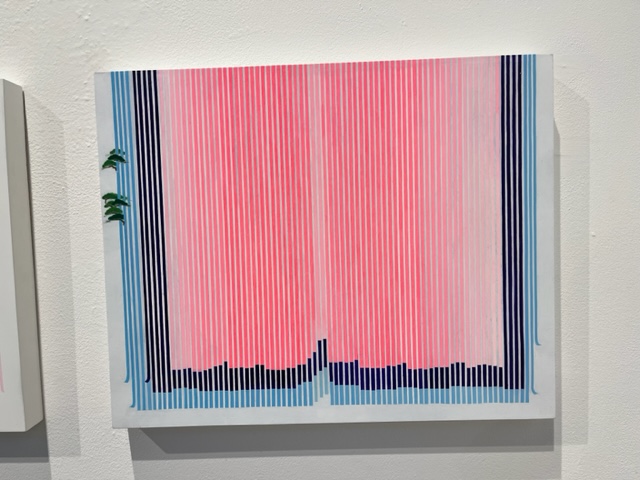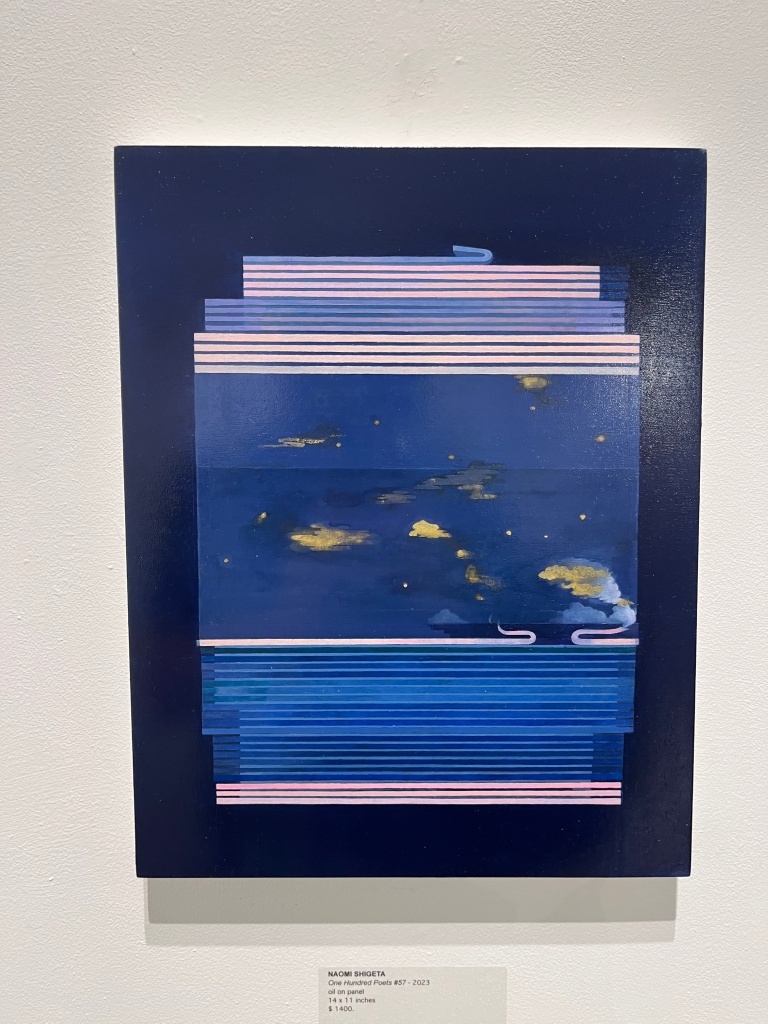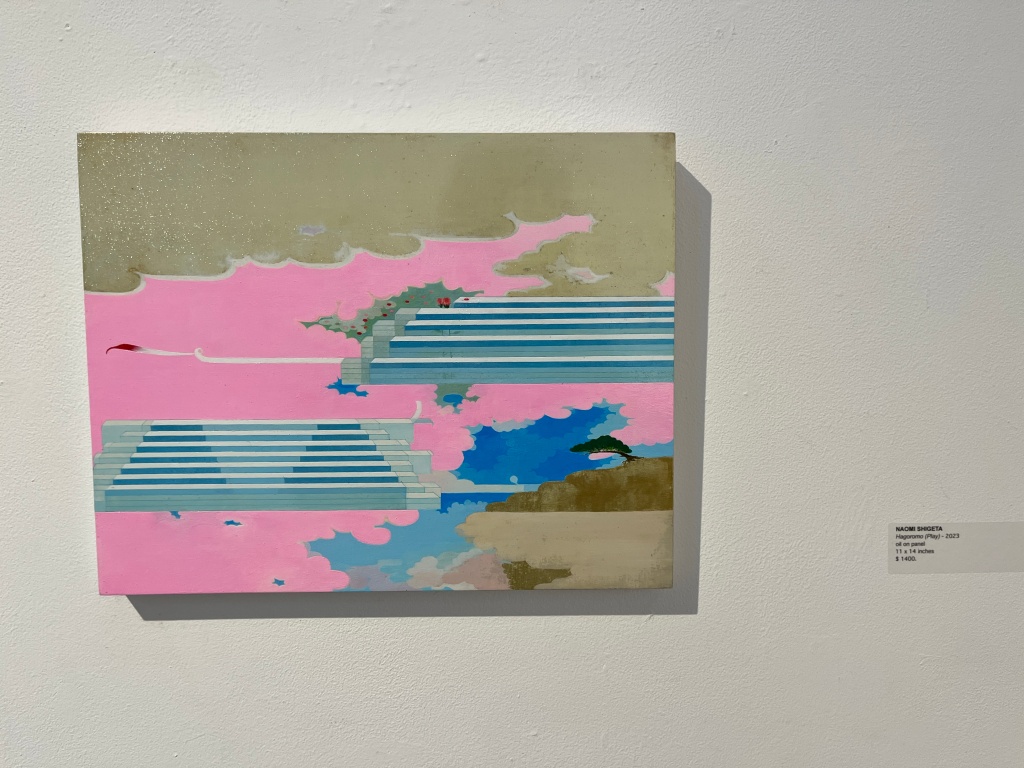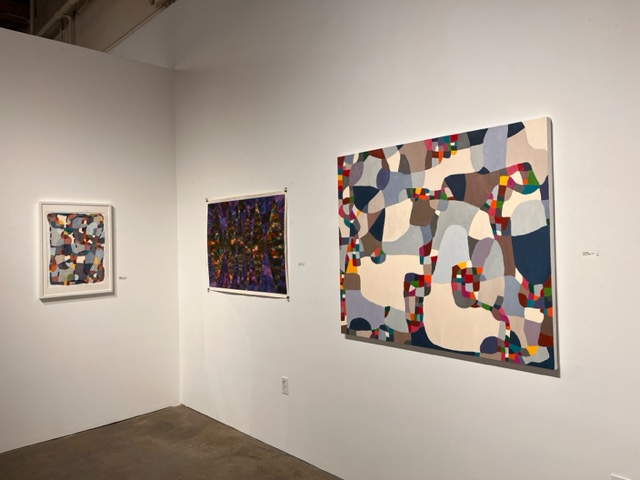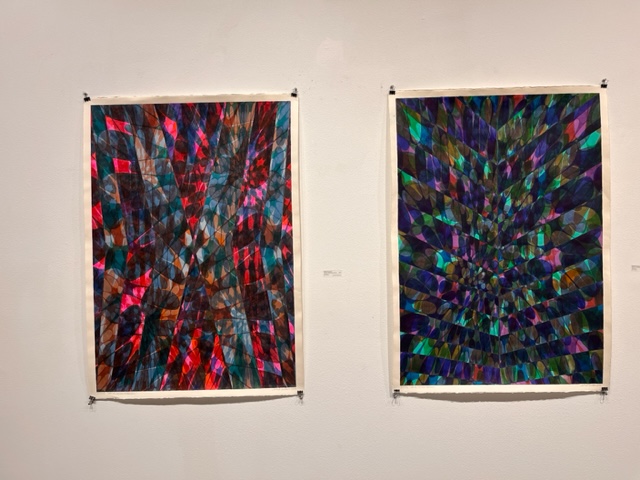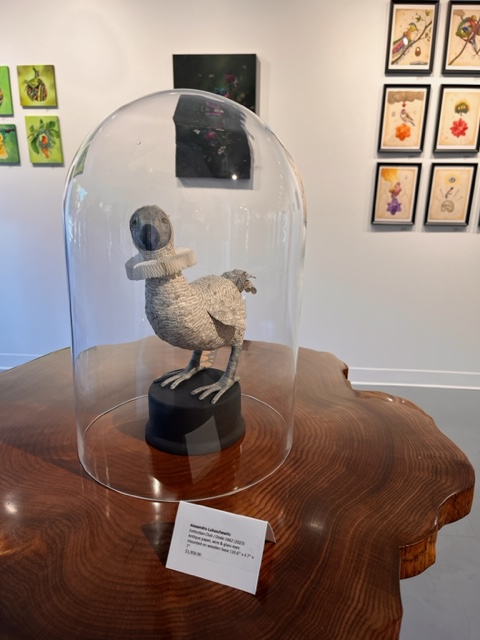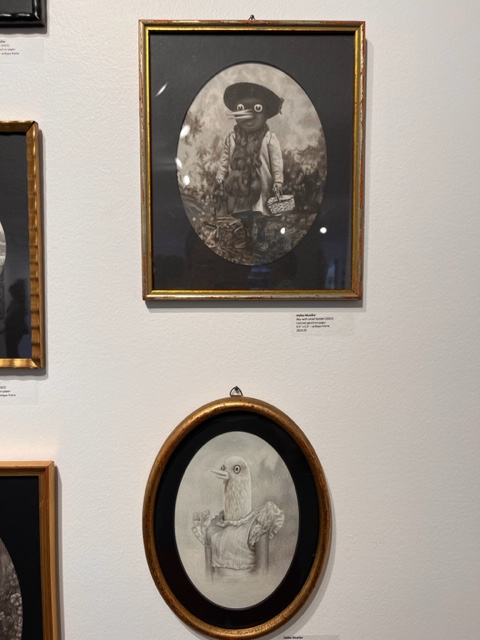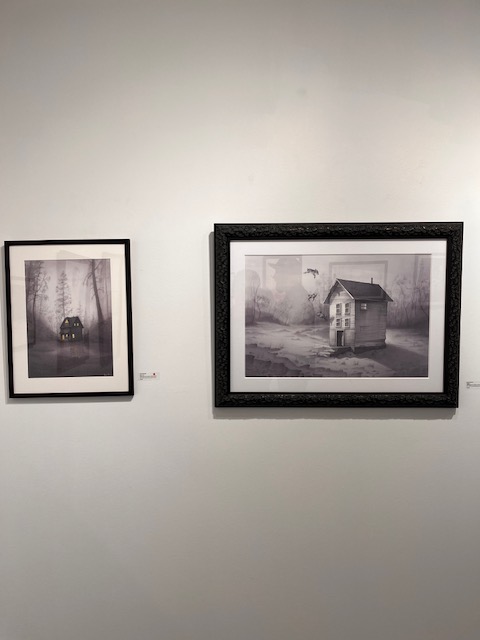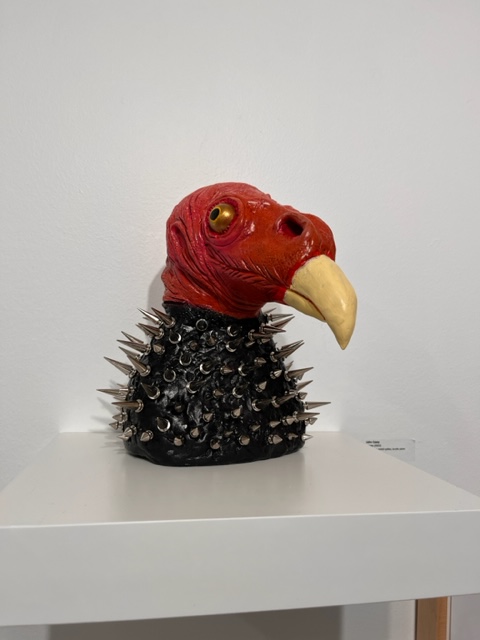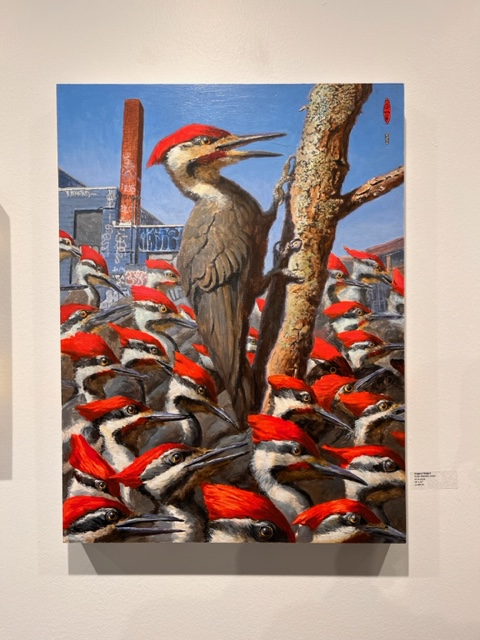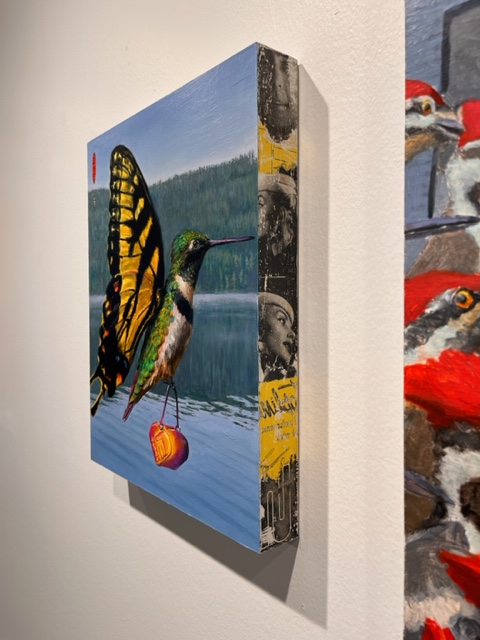Portland’s galleries rarely disappoint, but this month the shows are particularly strong. Even if you missed the energetic openings, there’s plenty of time to head out and take in some serious art.
Sherrie Wolf’s solo exhibition Animaliere at Russo Lee Gallery is a place where still life and animal paintings meet her signature hyper-realism style. As you can see, Sherrie spends a lot of time arranging objects. In addition, easy access to high-quality reproductions means that she does not need to visit museums to bring an aura of old masters into her synthetic compositions. In the case of the painting with a zebra, she brought a print up close. The perspective gives the illusion that a tabletop of still life with a peach, a cherry, and a lily flower is propped against a lush forest and the gaze of a zebra.
Despite her numerous references through embedded postcards or compositions from Dutch, English, and French paintings, Wolf’s aesthetics are unmistakably contemporary. The first clue of the post-modernism is the juxtaposition of objects. In still-life paintings from the Dutch golden age, the arrangement has always been carefully devised and balanced such that the bountifulness is a reminder of the avoidance of gluttony and waste. In contrast, Wolf’s compositions are seemingly casual with complex structures and technical challenges. Besides the composition, the light feels sharper and more defined. The reflected and diffused light brightens the imagery as if objects are staged in the lobby of a brightly-lit office building, a contrast to the soft glow out of windows in a Dutch Gable house. A few smaller works are displayed in a project room. In Juan, Wolf placed a tulip in a tall glass against the famous painting by Velasquez. However, the subject, Juan de Pareja was an assistant and a noted painter in his own right. Wolf did not paint the portrait based on the recent exhibition at the Metropolitan Museum of Art which focuses on Juan’s own work. Yet, the flesh, blurred and slightly distorted behind the glass, benefits from the optical phenomenon of additional visual noise and texture we tend to associate with real-world objects. In doing so, Wolf humanizes the sitter and enlivens him from the painting itself.
Joanie Krug’s show Exuberance at Gallery 114 is another worthy stop on your gallery hop. Krug’s works have an expressive quality that recalls the Bay Area Figurative Movement. Yet she is more modest in both the scale and her choice of colors. Joanie subdues her color palette to a limited range, from an earthy warm tone to gray blue, and green. With little detail and vivid emotions, the results are like our own recollections visited through the portals of faded photos. Perhaps things that we cannot remember well are not worth remembering anyway. Thus the economy of Krug’s gestural brushstrokes are both the means and the goals of capturing the essence of each cherished life moment: We see the interaction and the movement through the lens of nostalgia and tenderness.
Indeed, each painting has its own memory. Often Krug works with some basic reference; and then develops, changes, and redevelops compositions until it feels right. “The texture comes from many layers that I have covered,” she shared on our visit to the gallery.
A few paintings in the show follow the leapfrog theme. ” This type of activity needs a lot of space,” said Krug when I asked if the background was meant to be a beach. “I probably have done leapfrog when I was a kid. But that was a long time ago. I cannot remember it now.”
I have not seen much fabric art since the last exhibition of Shelia Hicks at the Nasher Sculpture Garden in Dallas. I assume it is because it is a difficult medium. Supple and pliable materials, by their nature, are very much against the grain of our notion of sculpture. The intensive labor from Kristy Kún’s fabric sculptural work at Waterstone Gallery isn’t obvious at first sight. Despite the massive scale, she uses almost no wire or other type of supporting hardware. For each piece, Kristy makes felt first from wool and then begins to fabricate through a deliberate process, including adding starch and moisture, layering material against contour props to create folds and suspension, and here and there, adding a few stitches to secure the shape. Artists have not always found a way to produce with an economy that can be scaled. And I am glad that is still the case.
Kún’s work has the airy quality intrinsic to fabric material. I couldn’t help holding my breath when I walked around to see the intricate negative space as if a sigh would blow it away. Conceptually, it also challenges our notion of fragility. After all, suspended fabric is not supposed to keep curvilinear shapes for long. Here, it does, at the will of the artist.
In Kún, the contradiction of weight and weightlessness is spellbinding.
Naomi Shigeta is happy to share the excitement about the works in her current show, Correlate, at Augen Gallery. Looking at her work, I would imagine a larger-than-life Agnes Martin-type personality. After all, who could endure painting precise geometric lines, by hand, in oil, for weeks, if not months? In person, Naomi talks about her work with genuine sincerity and humility. In fact, she might be one of the nicest, most engaging artist personalities in Portland.
Before you ask, she doesn’t use tape., She says taping usually does not work well with oil. It messes up the edges. Instead, she applies paint thinly, stroke by stroke, and layer after layer, to achieve machine-level perfection.
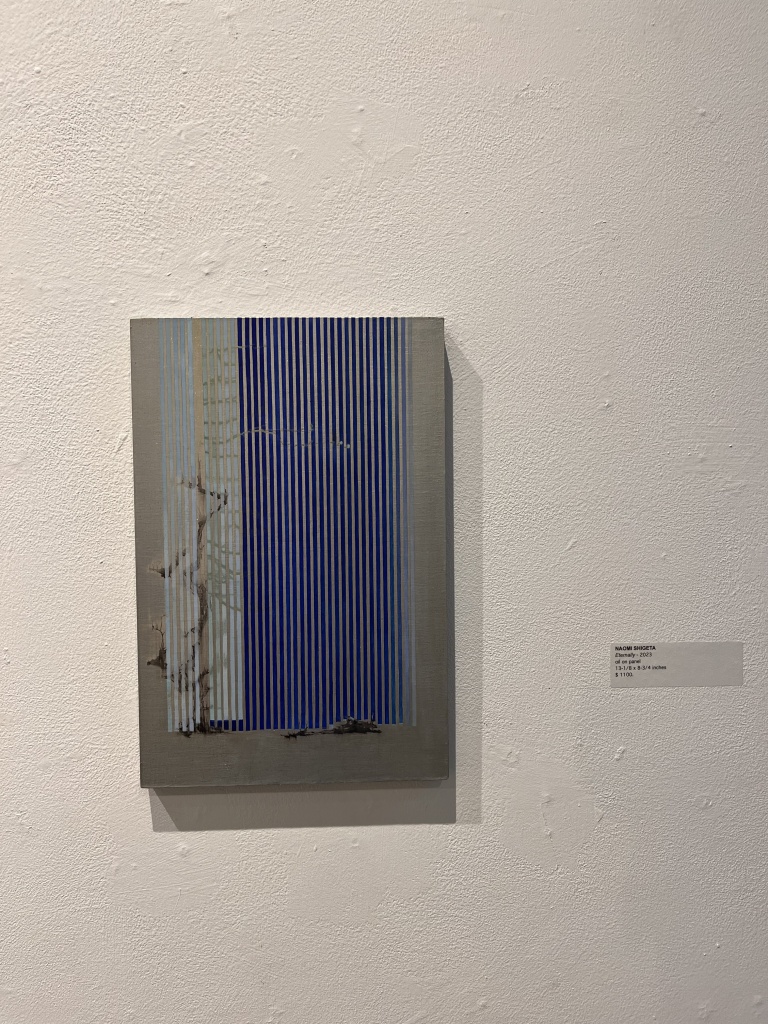
Although they do share an affinity with Agnes to the intensity of creative processes, Naomi does not follow pure abstraction. Often, the precise lines are superimposed over a more fluid abstraction that seems to stem from nature. In one case, a calligraphy-inspired tree pattern is interspersed between vertical stripes. Part of the branches are a lighter tone, a concept often adopted in oriental ink-wash painting to create volume. (Naomi named Sesshu Toyo, who learned ink-wash painting from China and created a new style of Japanese painting.) Was it a shadow play? When you move in for an up-close look, you may be pulled away by the vertical stripes striking together like tutti forte. Pale and dark blue blocks divide the imagery. Against that drastic shift, the same silver-toned stripes transition from the source of shadow to the source of light. It is a visual wonder to see two different forces, strong will against free will, colliding on a single canvas.
We were lucky that Blackfish Gallery offered extended hours during the opening night. Carol Benson and Michael Knutson complement each other with the abstraction of interlocking shapes. Benson’s works feel more organic and analog while Knutson’s watercolor features sharply delineated shapes throbbing in an imagined digital space.
A little off the beaten path, Brassworks Gallery doesn’t conform to opening nights, but it’s worth a special trip. On view now is the Birds Rising Group Show. Artist Heiko Mueller from Germany curated with show, bringing together artworks from several countries. The styles and mediums are no less diverse and include sculpture, paper, paint and drawing with subjects spanning from surrealism to fantasy. There’s no bird quite like the woodpecker and cofound Gregory Hagert’s own work may be some of the best in the show. He includes thoughtful treatment of the canvas edges, a surface often ignored or treated in attempts to make it recede from view. Adjacent is a room of red dots on works by Annie Owens, co-founder of Hi-Fructose Magazine.
Discover more from Urban Art & Antiques
Subscribe to get the latest posts sent to your email.

